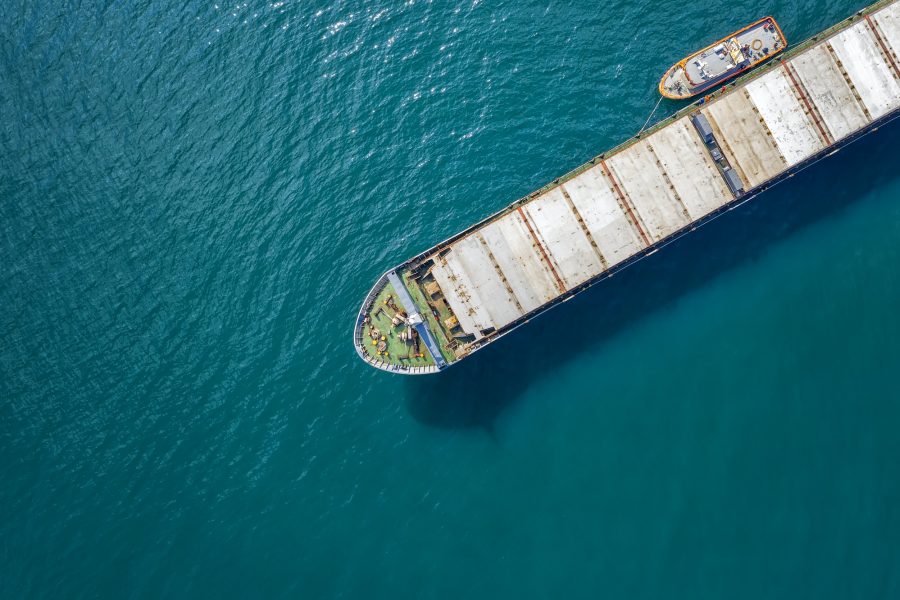Emissions from ships are important contributors to global climate change and local air pollution, putting pressure on the environment and humans. A new generation of bunker fuels, so called zero-emission fuels, can help to address this challenge while also creating a major business opportunity in developing countries.
Currently, ships contribute about 2-3% of all global greenhouse (GHG) emissions—more than Germany’s entire annual emissions and thus making shipping the 6th largest emitter worldwide. Over the next 30 years, international maritime transport seeks to reduce its GHG emissions by at least 50%. Full decarbonization, meaning zero-emission vessels across all oceans, is to be reached as quickly as possible within this century. This is what the International Maritime Organization (IMO) has committed to in its initial strategy on the reduction of GHG emissions from ships.
Ships are also responsible for a significant share of air pollution. About 15% of premature mortality associated with air pollution from transportation is attributed to shipping. Air pollution from shipping causes roughly 60,000 premature deaths annually—primarily in China, Japan, and India, especially in coastal and urban areas near major ports.
The need for and action towards zero-emission shipping fuels
The reason for this double challenge—GHG emissions and air pollution—is the fuel that ships are primarily using: heavy fuel oil (HFO). HFO is a high-carbon, high-sulphur residual substance left over from the process of refining crude oil after the lighter fractions such as kerosene, jet fuel, gasoline and highway diesel have been removed. It looks like what most people know as “tar” and is so thick and viscous at room temperature that it needs to be heated before it can flow well enough to be properly combusted in a shipping engine. While increased energy efficiency efforts and recent regulation such as IMO2020 (a new sulphur cap for HFO) have an important role to play, those alone will be insufficient to reach the 50% GHG reduction target by 2050. The only way this can be achieved is by a rapid energy transition away from fossil fuels towards a new generation of alternative fuels with zero emissions.
Against this backdrop, the Getting to Zero Coalition, an alliance of more than 90 companies within the maritime industry, supported by intergovernmental organizations such as the World Bank, is pursuing the vision of developing and deploying the first commercially viable deep sea zero-emission vessels by 2030. Maersk, the world’s largest container shipping company and a leading member of the Getting to Zero Coalition, has announced the company’s climate plan to make its entire fleet completely carbon neutral by 2050.
Countries are also supporting the vision of zero-emission shipping. The United Kingdom requires all new UK ships ordered from 2025 have zero-emission technologies on board. A group of seven Pacific islands, namely Fiji, the Marshall Islands, Kiribati, Samoa, the Solomon Islands, Tuvalu, and Vanuatu, started the Pacific Blue Shipping Partnership. These islands have partnered up to fully decarbonize shipping in the Pacific Ocean by the middle of the century.
To maximize environmental benefits, it will be of utmost importance that the new fuels themselves be produced using renewable energy such as solar, wind or hydro power. For instance, work has just started in Norway to retrofit the first ocean-going vessel powered by ammonia that is “green”, i.e. produced using only renewable energy.
A major business opportunity for developing countries
A recent analysis by the Getting to Zero Coalition published at the World Economic Forum 2020 in Davos estimates that between $1 trillion to $1.4 trillion of investments will be needed from 2030 until 2050 to at least halve the shipping sector’s emissions until the middle of the century. $1.4 to $1.9 trillion (i.e. $400-500 million more) may be required to fully decarbonize shipping in the same time frame. While this may sound like a big financial challenge, annual global energy investments in 2018 amounted to more than $ 1.8 trillion. 87% of the total investments required for zero-emission shipping is expected to be linked to land-based infrastructure such as hydrogen production, ammonia synthesis and storage/distribution. Only 13% will go toward building new vessels or retrofitting existing ones.
This presents a major business opportunity for the World Bank’s client countries. Developing countries are major players in international shipping. In 2016, developing countries accounted for more than 60% of global outbound/exports loaded, more than 40% of vessel ownership and about 80% of vessel registration. Among the world’s 20 largest ports, 15 are currently located in developing countries, many of which have the potential to take advantage of host countries’ abundant renewable energy sources.
The business case for zero-emission fuel production in developing countries
Producing and supplying zero-emission fuels to a global fleet offers a major opportunity for the economic development of these countries. Initial studies by the Environmental Defense Fund have looked into these opportunities using Morocco and Chile as case studies. More country case studies are to follow. Supported by PROBLUE, a multi-donor trust fund supporting the blue economy, the World Bank has started to assess its client countries’ potential for becoming zero-emission fuel hubs on a global level.
Even when a country may not be large enough to become a global player in the zero-emission fuel supply chain, the economic opportunity still holds. Let’s take the example of Small Island Developing States (SIDS), where shipping ensures vital connectivity between the islands and the rest of the world. SIDS currently spend a large proportion of their gross domestic product (GDP) on fossil fuel imports, mainly oil. In the case of Fiji, these oil imports account for 14-17% of GDP annually. As the sector transitions to the next generation of bunker fuels, replacing some of these imports with self-produced, clean transport fuels could free up significant public resources in the long run.
For a very long time, the emissions produced by ships that carry global trade have been harmful to our climate and to human health. However, with new initiatives set in motion by the member states of the IMO and the private sector, there is a momentum to finally decarbonize the sector. The new generation of zero-emission fuels for maritime transport will not only benefit the global fight against climate change and the local need for better air quality. But they also offer a $1+ trillion investment opportunity in developing countries. So, let’s bring everybody on board to seize it!
For more details, please visit: https://blogs.worldbank.org/transport/zero-emission-shipping-whats-it-developing-countries


